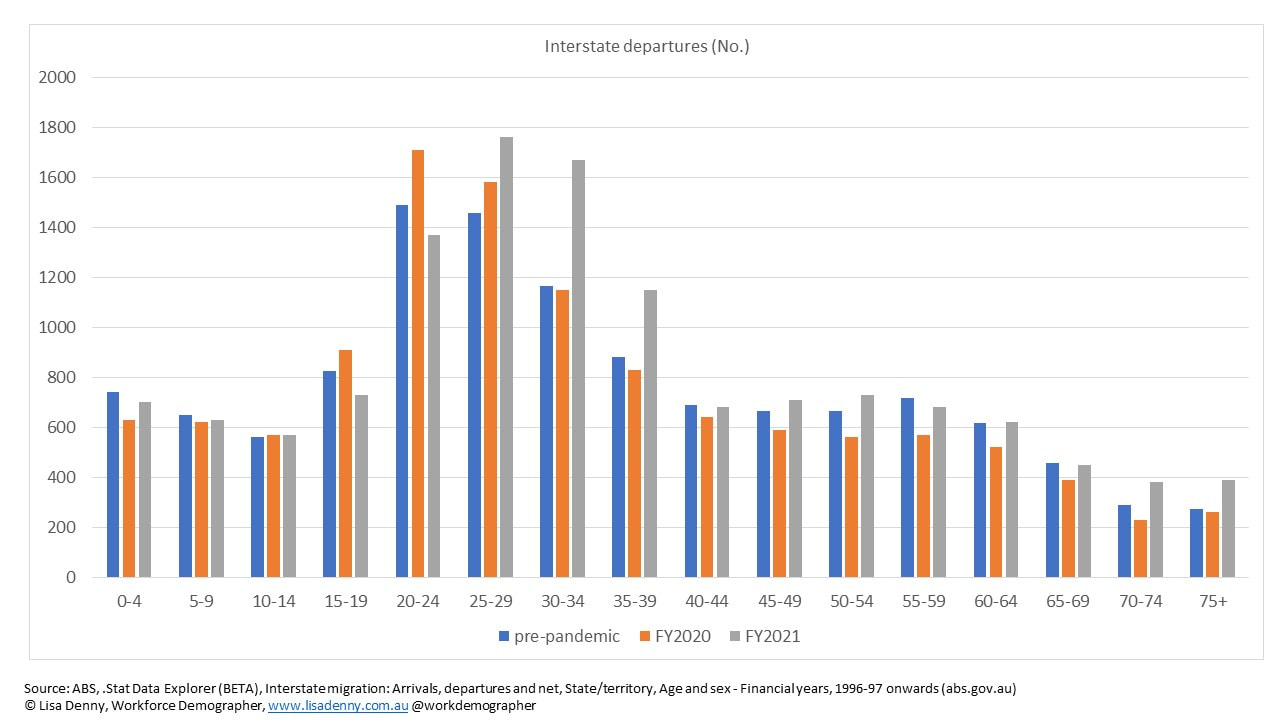The data for the financial year ending June 2021 reveals a dramatic change in the age profile of those moving to Tasmania and those leaving Tasmania compared with the pre-pandemic profile (the average for 2017 to 2019 financial year data).
If this interstate migration age profile continues, it is likely to have serious implications for economic production and demographic reproduction for Tasmania.
While a quick summary of the interstate migration data reveals that Tasmania recorded a small net loss of 110 people for FY2021 - contrary to popular belief - driven by a 5.9% decline in arrivals to the state and an 8.8% increase in departures from the state, the devil is in the detail.
The age profile of interstate migration for FY 2021 is not comparable to previous years going back to 1998. The most comparable age profile is for 2002, prior to the economic growth period of the early- to mid-2000s.
For FY2021, Tasmania recorded a reversal of pre-pandemic trends with significant net interstate migration losses for those aged 20 to 34, and smaller, comparable losses for those aged 15 to 19. A net loss was also recorded for those aged 35 to 39 and 70 and older, and zero for those aged 5 to 9, whereas net gains had been recorded for these age groups prior to the pandemic.
Net interstate migration gains were recorded for those aged 0 to 4 and 44 to 69, however at lower levels than prior to the pandemic, except for those aged 55 to 59 years which increased by 10%.
Considerably higher numbers of Tasmanians aged 25 to 39 left the state during FY 2021, compared with the pre-pandemic average. A smaller increase in the number of Tasmanians aged 44 to 54 and those aged 70 or older was recorded.
Compared with pre-pandemic levels, interstate arrivals declined for all age groups 0 to 29, ranging from a decline of 28.3% for those aged 20 to 24 to 11% for those aged 15 to 19. Arrivals increased for all age groups aged 35 to 64, ranging from 18.7% for those aged 50 to 54 to 1.6% for those aged 45 to 49 years.
What the data does not tell us is why this occurred. Historically, the decision to relocate is made based on relative economic opportunities, housing affordability, and/or family reasons. Border closures may have also contributed to these changes during the FY 2021. Interestingly, research out of the Australian Government's Centre for Population finds that "Relative property prices in states and territories appear to have a greater influence than relative unemployment rates on interstate migration. A five per cent increase in property prices will increase the number of people migrating out of that state by 1.0 per cent."
While we continue to live during a period of a global pandemic, it is difficult to predict if this age profile pattern will continue. While this age profile data is for the FY2021 period only, interstate migration for the September 2021 quarter showed a further significant increase in net interstate migration loss, led by a 40% increase in interstate departures compared with the previous year. Interestingly, this occurred while both NSW and Victoria were in lockdown. Given this, further exploration of the reasons for Tasmanians leaving the state is warranted.
While a government spokesperson may suggest that this significant shift in the interstate migration age profile is the result of the pandemic and could not be foreseen, I suggest that this trend had begun prior to the pandemic and that it is the repercussion from failing to plan appropriately for the population growth that preceded the pandemic, but was potentially exacerbated by the pandemic. As such, the Tasmania Government’s Population Growth Strategy requires an urgent review.




